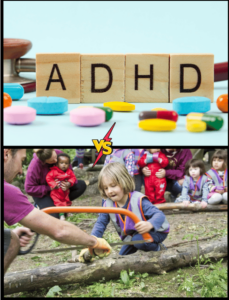Over the last few decades, ADHD has been one of the most common diagnoses for young kids – especially boys – who struggle with focus, impulsivity, and hyperactivity in structured environments. But what if, instead of a disorder, these traits were actually remnants of an evolutionary advantage? Could modern schooling be the problem, not the child?
The expectation for boys to sit still, focus, and follow rigid classroom structures often blatantly contradicts their natural biological tendencies. Historically, movement, exploration, and quick decision-making were survival skills – traits that could be labeled today as symptoms of ADHD.
Here we’ll take a deeper look at whether we are pathologizing natural instincts and what we can do to better support boys in our modern world.
The Evolutionary Case for Hyperactivity
Before the advent of agriculture, humans lived as hunter-gatherers for thousands, or perhaps millions, of years. This lifestyle required constant movement, quick reflexes, and a heightened awareness of the environment. In this setting, what we now call ADHD traits – impulsivity, hyperactivity, and novelty-seeking – would have been assets rather than liabilities.
perhaps millions, of years. This lifestyle required constant movement, quick reflexes, and a heightened awareness of the environment. In this setting, what we now call ADHD traits – impulsivity, hyperactivity, and novelty-seeking – would have been assets rather than liabilities.
A 2008 study from Northwestern University examined the DRD4 7R gene, often linked to ADHD and novelty-seeking behavior, in two Kenyan communities: one still practicing a nomadic lifestyle and another that had transitioned to farming. The study found that nomadic individuals with this gene were better nourished, suggesting that their hyperactivity helped them thrive in an environment that required adaptability. Conversely, individuals with the same genetic traits in the settled community struggled more, particularly in classroom settings.
This finding suggests that ADHD-like traits were once crucial for survival but are now seen as disruptive because modern life does not always necessitate the same instincts.
Additionally, hyperactivity and distractibility, two key symptoms of ADHD, could have been essential in ancestral environments for avoiding threats, tracking animals, and responding quickly to new situations. A highly perceptive and reactive individual would have been an asset to any hunting party, constantly scanning for danger or opportunities. In contrast, modern classrooms demand prolonged periods of stillness, which can be extremely challenging for children wired for movement and rapid response.
Why Traditional Schooling Fails Boys
Most modern education systems are built around a sedentary learning model – students sit for long periods, listen passively, and are expected to stay focused on material that may not immediately interest them. This model is especially difficult for boys, who are naturally more inclined toward physical movement and hands-on learning.
Research shows that boys are diagnosed with ADHD at more than twice the rate of girls or even 10 to 1 depending on how you approach the study, in part because they exhibit more outward hyperactivity. But is this really a disorder, or just an incompatibility between their natural energy levels and the school system’s structure?
The Need for Physical Activity
Many schools today have reduced recess times and limited opportunities for physical play, yet movement is critical for learning and brain function. Studies indicate that physical activity improves concentration, mood regulation, and cognitive development in children.
Dr. Leela R. Magavi, a psychiatrist specializing in ADHD, notes that increased movement – whether through extended recess, interactive learning, or kinetic teaching methods – helps children perform better academically and behaviorally. Instead of forcing boys to conform to an unnatural learning environment, schools should incorporate more movement-friendly teaching styles.
Studies also show that kinesthetic learning – where students learn through hands-on experiences – can be especially effective for boys. Incorporating movement into lesson plans, such as allowing students to walk while discussing concepts or using interactive exercises, could help bridge the gap between the natural needs of boys and traditional educational expectations.
Medication vs. Accommodation: A Necessary Debate
With the rise in ADHD diagnoses has come a surge in medication prescriptions, particularly stimulants like Ritalin and Adderall. While these medications can be helpful for some, they are often prescribed as the first line of treatment rather than exploring environmental accommodations first.
particularly stimulants like Ritalin and Adderall. While these medications can be helpful for some, they are often prescribed as the first line of treatment rather than exploring environmental accommodations first.
Medication addresses symptoms but does not tackle the root issue: the mismatch between innate biological tendencies and modern schooling. Instead of defaulting to medication, we should first ask whether a child’s environment is supporting their natural strengths.
Reframing ADHD as a Strength
Many traits associated with ADHD – high energy, creativity, and hyperfocus – are valuable in certain settings. Entrepreneurs, athletes, and emergency responders often exhibit these qualities, using them to their advantage. Instead of treating ADHD as a disorder, we should reframe it as an alternative way of thinking that needs the right environment to flourish.
In addition, recent research suggests that individuals with ADHD often excel in dynamic environments where quick thinking and adaptability are required. This could explain why many successful business leaders and innovators credit their ADHD as a driving force behind their achievements. Instead of suppressing these traits, we should nurture them in ways that allow boys to channel their energy productively.
Creating a Better Learning Environment
Education reform is necessary as is, but is even more necessary if we want to accommodate children who learn best through movement. Some successful strategies include:
- Longer recess periods to allow for physical release and reset.
- Interactive, hands-on learning such as experiments, group discussions, and creative projects.
- Flexible seating options like standing desks or balance chairs to help children focus while still allowing movement.

Encouraging Alternative Education Models
Some educational models, such as Montessori or Forest Schools, integrate movement and exploration into daily learning. These schools recognize that children, especially boys, learn best through doing rather than passive listening.
Parents can also seek out extracurricular activities that align with their child’s strengths – such as martial arts, sports, or outdoor adventure programs – to provide a healthy outlet for their energy and curiosity.
Closing Thoughts
The increasing prevalence of ADHD diagnoses in young boys raises an important question: Are we misdiagnosing natural hunter-gatherer instincts as a disorder? The modern school system is largely misaligned with the biological needs of boys, often, sadly, leading to unnecessary medication and missed opportunities for growth.
Rather than suppressing restlessness with medication, we should be designing learning environments that embrace movement, curiosity, and hands-on learning. By shifting our perspective, we can create a world where boys’ natural tendencies are seen not as problems, but as strengths.
In the end, recognizing ADHD-like traits as evolutionary features – not issues – can help reshape our approach to education and childhood development. Instead of forcing boys to conform to rigid, outdated models of learning, we should be asking how we can better accommodate their instincts. The goal should not be to make them fit the system, but to adapt the system to better fit them.









